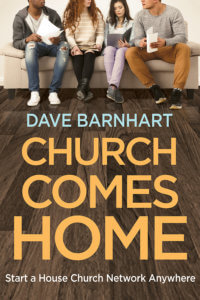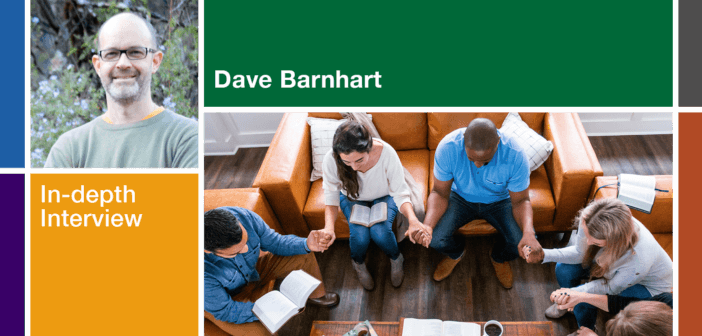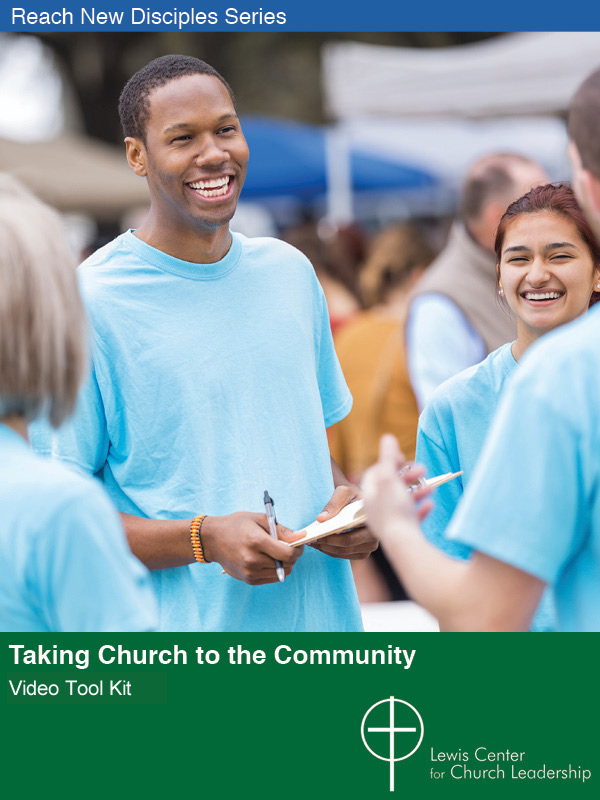The pandemic taught us that church happens in powerful and meaningful ways outside our buildings. Ann Michel of the Lewis Center staff interviews Dave Barnhart, author of Church Comes Home, on how small, home-centered worshiping communities can connect with people who may never cross the threshold of your church building.
Listen to this interview, watch the interview video on YouTube, or continue reading.
Ann Michel: Could you share a bit of the story of how you got involved as a planter and leader of house churches?
David Barnhart: We live in Alabama, which is one of the most churched places around. But it also means that people who are unchurched or seeking can feel very isolated and marginalized by the Christian fundamentalist culture. For a long time, I’d had the idea of starting a church for that affinity group — people who’ve been hurt or burned by church or don’t feel they fit in. In 2012, we started a more conventional church. We had a band. We had a venue. But a lot of people who came had one of two reactions. Some would say, “Hey this is great!” But then they wouldn’t come back. Others would tell me, “I love your theology. I love the way you’re trying to reach people who don’t feel like they fit. I love what you’re doing. But I’m never going to church again.” I struggled with how to create sticking power.
The place we got the most traction was in our small groups. And so, in 2016 we pivoted to really focus on those smaller, intentional groups. And that’s where the house church concept blossomed, and we’ve had a lot of success. At one point we had six house churches and about half the people attending were those who hadn’t been to church in six months. So, we were really getting some good traction.
House church has been going on for a very long time, since the beginning, really. But in learning about house church, we had to adapt some of what was already out there. We started doing something that was a little more intentionally liturgical. We read scripture responsively, kind of a call and response. We have a liturgy. Oftentimes we use Common Prayer by Shane Claiborne, Enuma Okoro, and Jonathan Wilson-Hartgrove. Recently, we’ve started creating a liturgy out of Wil Gafney’s book, A Women’s Lectionary for the Whole Church Year. We have a guided prayer time. We do communion. Sometimes we sing. I’ll admit music is typically not great in a house church unless you’ve got some very talented people. But the most important thing is we have conversation. Instead of me standing up and talking to people, they’re bringing their own perspectives. The conversation is really where a lot of the discipleship and spiritual growth happens.
Ann Michel: Can you define “house church” and describe how house churches are distinct from other religious gatherings in people’s homes or other noninstitutional settings?
David Barnhart: There are certainly lots of other ways that discipleship happens in homes — small groups, book studies, a variety of things. And we do some of those things. One of the biggest confusions is people think of house churches as small groups. And they do have a lot in common. But what really distinguishes a house church from these other things is that a house church is someone’s primary worshiping community. The house gathering is the worship experience, not something done in addition to a worship experience that happens elsewhere. Also, it’s intentionally small. Usually, a dozen to 20 people at the most. That’s it in a nutshell.
Ann Michel: You serve a network of house churches you’ve planted. Can you describe those communities and how they connect to one another?
David Barnhart: Things have been a little different for the last two years because of COVID, but at our peak we had six house churches. To be honest, that’s a little too much for one person. Four house churches are about ideal. We meet at different times and in different places. Wednesday night is a group of people who work on Sundays and couldn’t go to a Sunday church. We have groups in Birmingham and in Huntsville. We will often have one in the morning and one in afternoon. Typically, I drive around to be with these different churches, but people serving as lay pastors also help lead.
I work very closely with them because I’m essentially training them to do what I’m doing. And this allows us to reach people I couldn’t otherwise reach. One of our house churches is led by a Black man who does a lot of work in HIV prevention. He has access to people I could never reach. I have a woman intern working with me now who’s reaching people who wouldn’t trust a man as their pastor. And I feel this is a way we can overcome some of the church hurt that keeps people from accessing church and from hearing the Good News. This is one of the powerful things about house churches.
Ann Michel: Your book is very balanced and realistic in assessing both the strengths and the weaknesses of house churches. What do you see as some of the strengths of house churches and what are some of the limitations?
David Barnhart: A definite strength of house churches is their versatility in the sense that “Jesus throws the seed and wherever the seed lands a house church can grow.” It’s a very distributed model of how we can reach a wide variety of people. As a straight white guy, there are people that I’m not going to reach because I’m just automatically suspect. Another great thing about a distributed network is, if something happens to me, these house churches are going to keep meeting. I don’t have to be present for them. And it’s such a simple model that it’s easily reproducible. Especially as I think about the future, things like COVID, and climate change, and other global crises, I feel house churches are going to be very resilient because they’re not dependent upon top heavy structure.
But there are things that house churches just can’t do, things that legacy churches do better because there are economies of scale. Legacy churches are able to have more programs, especially for children and young people. They’re going to have a little more leverage to do large programs, things like buying medical debt for folks. Whether people are conservative or liberal, people are very suspicious right now. There’s such distrust of institutions across the range, whether we’re talking political institutions or faith institutions. And to be able to reach people who have questions about, “Who are you really representing?” and “What’s your real angle?” One of the things that house churches can do is say, “Come have dinner. Let’s have a conversation.” That’s where the genuine human connection happens. That’s where discipleship happens, I think.
Ann Michel: Given your definition and experience of house church, what are you seeing evolve as virtual ministry that has become more popular in the wake of COVID?
David Barnhart: I think our style fits really well with virtual ministry because music wasn’t one of our big strengths anyway. Conversation really is our strength. Webinars work really well for that style of participatory preaching. I usually talk for about 10 to 15 minutes and then most of the rest of it is conversation. And the worship leaders of our other house churches typically are my webinar conversation partners. And then we take comments from Facebook and YouTube and the Zoom chat. And it has worked really well. The thing is, if people are reluctant to go to church for health reasons, then they’re also not likely to want people in their homes for health reasons. But we’ve been doing a lot of meeting outside. That’s more of a social thing, getting together for meals and conversation, whereas worship happens online in the conversational format.
Ann Michel: Do you imagine going forward that there might be house churches that exists solely in virtual space? Do you see that as an extension of the movement?
David Barnhart: I certainly can see that as a possibility. Many people aren’t aware of the number of people who have social anxiety and other things that prevent them from going to large gatherings. And if you’re working with people who don’t want to leave their home, then online is great. But part of the strength of house churches is their intimate connection, and we’ve felt a loss of that.
Ann Michel: Some of your churches have a certain niche character, bringing together people who have a certain affinity. And in a virtual space, you may have the ability to gather people who share that affinity, even if they aren’t necessarily neighbors.
David Barnhart: That’s definitely the case. This is very niche. If you’re after the people who aren’t going to come to church, you’re after a niche and you’re recognizing how hard it is. All the church planting conferences and trainings I’ve gone to have very triumphalist ideas about gathering people and reaching the unchurched. And most of the time, it’s about getting them to come to our thing. And I just feel like that’s not going to reach the people who aren’t already willing to come to your thing.
Ann Michel: Are there any lessons from your work with house churches for those of us in legacy churches who are nevertheless interested in practicing faith more intentionally at home or in small gatherings?
David Barnhart: There are rituals you can do at home that are personally meaningful. One that comes to mind is doing an Epiphany House Blessing, which is a tradition that began in the Church of England, I think. The idea is you chalk a blessing over your door, and there’s a little recitation that you do. It’s great to do with kids, especially if you can pick a kid up and hold them and let them chalk over the door.
This may sound a little scandalous, but when I think about the people who are interested in “DIY religion,” New Age practices, and that kind of stuff, so much of it is things you can do at home. Regardless of whether you agree with it or whether it fits your theology, the point is they’re doing something at home, right? So often, the message of mainline denominations is, “Come here. This is where religion happens, at our location.” But giving people the tools to do ritual at home today connects them to something bigger than themselves. I think that’s so important.
Ann Michel: You wrote, when a pastor sits among many in a circle, instead of standing in front and preaching to an audience, the dynamic changes. Could you comment on the leadership dynamic within house churches and what intentional leadership development practices you are cultivating.
David Barnhart: My discipleship model is really based on Covenant Discipleship groups which have this beautiful, holistic idea of worship, devotion, compassion, and justice. We added witness to that, so there are five areas of discipleship; and we’re always engaging each of those areas, both as individuals and then as a community. So, we think about each of these areas of Christian leadership and teach people. “This is why we do justice.” “This is why we do devotion.” And the question of how to make it a lived experience is something the whole community possesses. The “sage on the stage” model of preaching just doesn’t work very well, right? I feel house churches are closer to things like intentional community or “the new monasticism.” I think there’s a craving to consider what faith means in our lived experience among friends and neighbors.
Ann Michel. It sounds like you are working to mentor others to lead house churches themselves. What is that like?
David Barnhart: It’s interesting because I’ve just sort of bumped into people who tell me they resonate with house churches. And occasionally I’ll say, “Hey, if you want to talk about starting a house church.…” And someone will come to me and say “I really think I’m ready to do this.” Or “I’ve been thinking about this for a while, praying about this, and I feel like I have an ability to reach my friends who don’t go to church but who oftentimes express a longing. They’ve told me what they miss, but that they’re not going back for whatever reason. So, I want to create a community for them.”
I think God just provides those people. Here’s someone who has connections to someone I’m never going to have a connection to. I just work with that person to say, “This is how we do it.” And it’s an easily replicable model that can adapt to whatever their context is, whatever their cultural background is.
Ann Michel: In your book, you draw on the paradigm of church innovation with ideas such as “failing fast” or the house church movement as a “disrupter” in the broader church ecosystem. Can you speak to how you see house churches being an instrument of change and innovation?
Dave Barnhart. It doesn’t take $250,000 and four years of training to start a house church. You can launch it and, if it succeeds, great. If not, you don’t worry about it. Part of it is having a more “Buddhist mindset” about letting things go, right? If things don’t work the way you had in mind, it’s okay. You reached some people, right? You had some life-changing, valuable conversations. And I think that’s a ministry approach the broader church needs. Because we have such a corporate business mindset. Anything we do has to succeed and be “self-sustaining.” In church planting, the metric for success is if you are self-sustaining after a certain number of years. But honestly, that’s just not going to happen with house churches. I’m now aspiring to be bi-vocational so I can start more house churches without my income being dependent on this process. The fact is that most churches aren’t self-sustaining. They’re getting resources from other places. And honestly, the reason that they’ve grown in the way that they have, the reason we have very large churches and megachurches is more economic then spiritual. It’s because of the way that we extract and deploy resources.
Ann Michel. Is there a way of knowing how big the house church phenomenon is either within the U.S. or worldwide?
David Barnhart: It’s so impossible to measure. In places like China, house churches are the dominant form of church. There have been people in the nondenominational world who’ve been doing house churches for ages. Frank Viola is one of the big names from the ‘80s and ‘90s. I’m Methodist and our denominational structure is very interested in metrics. But house churches are so fluid. They’re so hard to count. Some of Frank Viola’s research found that the average lifespan of a house church is between six months and two years, I think. So, you’re not talking about something that’s going to be around for 100 years, where you can say “the membership number is X.” It’s much more amorphous. There are estimates that there are more people in house churches than are going to legacy churches, worldwide, especially. And I don’t know how you could ever measure that.
Then you also get in that fuzzy area of what do you consider “church?” Do they have to take up an offering? Do they have to do sacraments? And then suddenly you’re in a whole messy theological question.
Ann Michel: What are some of the key lessons that legacy churches can take away from what you’ve learned about house churches?
David Barnhart: I think one of the important things has to do with the idea of “programming.” In fact, I don’t even like the word anymore. I think so much of ministry needs to be more relational and not hang on to things that really ought to die. Oftentimes, we keep a program going because we don’t want to hurt someone’s ego instead of saying “Look, this thing was good. It served its purpose. Now let’s move on to something else.” We need to have more of a future orientation rather than the idea that “I’ve invested in X, and I need to keep it going.”
The other thing is we need to think of church as an ecosystem rather than an institution. So often, when we use the phrase “the institutional church” we’re just thinking about the denominational structures. That’s just one little piece of the full church ecosystem which includes publishers, consultants, academia. I want to include those things that don’t get captured, the intentional communities of people who don’t go to church but who have a religious orientation in their lives. I call them the mystics and monastics, the people who gather in informal communities. I think those are important aspects of church life that often get pushed to the side or get ignored.
 Related Resources
Related Resources
- Moving Beyond Church in A Box by Carey Nieuwhof
- The Bright Promise of Alternative Faith Communities by Ann A. Michel
- 7 Steps for Making Disciples Through Relational Mentoring by Ken Carter and Audrey Warren







